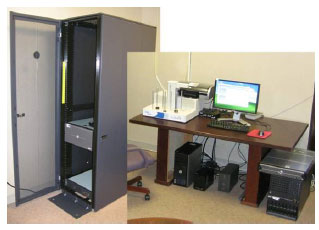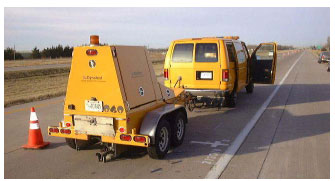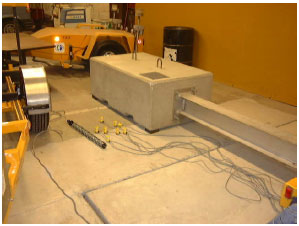U.S. Department of Transportation
Federal Highway Administration
1200 New Jersey Avenue, SE
Washington, DC 20590
202-366-4000
Federal Highway Administration Research and Technology
Coordinating, Developing, and Delivering Highway Transportation Innovations
|
LTPP News This newsletter is an archived publication and may contain dated technical, contact, and link information. |
|
| Publication Number: FHWA-HRT-09-066 Date: Summer 2009 |
Publication Number:
FHWA-HRT-09-066
Issue No: Vol. 5 No. 3 Date: Summer 2009 |
| Email Distribution List |
|
| Contact |
Customer Service
|
In September 2009, the Long-Term Pavement Performance (LTPP) Program will reach its 20-year monitoring milestone. One of the original LTPP program objectives was to collect and store pavement performance data over an extended period for analysis and product development. In support of this objective, the world's largest pavement research database, the LTPP Information Management System (IMS), was born. Twenty years later, this database is the premier product of the LTPP Program, the legacy of LTPP, and will serve the pavement research community for decades to come. This past spring, the Federal Highway Administration (FHWA) took delivery of a new IMS server that will be housed at the Turner-Fairbank Highway Research Center (TFHRC). The new server has 7 terabytes of storage capacity, equivalent of 7,000,000 megabytes, while 20 years ago the first server had only 320 megabytes of storage capacity.
The IMS has three main elements: the Pavement Performance Database (PPDB), the Central Traffic Database (CTDB) and the Ancillary Information Management System (AIMS). The PPDB is the component of the LTPP IMS that contains pavement-related data, computed parameters, and summary weather and traffic data. The CTDB is a large set of data files collected by the State Highway Agencies and processed by the LTPP regional contractors. Summary data from the CTDB is contained in the traffic module of the PPDB. The AIMS is the collection of LTPP items that are not contained in the PPDB or CTDB. All videos, photos, documents, raw data files, software, manuals, protocols, etc., created as part of the LTPP Program are part of the AIMS.
Currently, the three elements of the IMS are housed separately: the production PPDB is housed by the Technical Services Support Contractor (TSSC), in Oak Ridge, Tennessee; the production CTDB is housed by the TSSC, in Beltsville, Maryland; and AIMS items are stored in various places, including the regional offices (paper data forms, section-specific documents, etc.), the TFHRC building (scanned distress maps, distress videos, raw profile data, FWD history files, etc.), and the Materials Reference Library in Reno, Nevada (core samples, distress films, etc.).

Figure 1. LTPP Information Center at TFHRC.
In anticipation of the 20-year milestone and the end of the current LTPP TSSC in October 2009, the FHWA is taking additional steps to secure and preserve the legacy of LTPP by centralizing the three primary IMS elements in one location at the LTPP Information Center at the TFHRC.
In the spring of 2008, the LTPP Program successfully completed the transfer of one LTPP IMS server from the TSSC in Oak Ridge, Tennessee, to the new LTPP Information Center at the TFHRC in McLean, Virginia. This past spring, the FHWA procured a new Windows 2008 based Dell Server to reside at the TFHRC and to house all of the IMS elements. A contract was awarded to Science Applications International Corporation (SAIC), to provide hardware and software setup and maintenance as well as LTPP IMS operations training on the new server.
In early June, SAIC staff successfully performed the initial server setup and software installation on the new LTPP server. Preliminary backup and recovery procedures have been drafted, and operational training is scheduled to begin in the fall. In addition, the lack of redundancy in expertise for processing and uploading traffic data to the CTDB has been addressed by training two other individuals to perform the required functions: an FHWA staff member and an on-site support contract staff member. The traffic data that will be submitted in August by the LTPP regional contractors will be processed at the TFHRC. These data along with the pavement performance data will be made available on LTPP Standard Data Release 24 in January 2010.
The LTPP IMS server is up and running at the FHWA TFHRC site, marking continuing efforts to secure and preserve the legacy of the LTPP Program! For more information, contact Jane Jiang at jane.jiang@dot.gov or (202) 493-3149.
The Falling Weight Deflectometer (FWD) calibration system was developed in the early 1990s for the Strategic Highway Research Program's (SHRP) LTPP Program. This was necessary because at that time, a calibration protocol for FWDs did not exist and LTPP data quality standards required that there was some method of assurance that deflection data would be consistent and well documented. Four LTPP FWD Calibration Centers were constructed in Pennsylvania, Texas, Nevada, and Minnesota, and have been in existence for more than 15 years. The Nevada Center has since moved to Colorado, and additional centers opened in Montana and California.

Figure 2. LTPP FWD in Operation.
These calibration centers have been widely used by both public and private agencies for FWD calibration, providing a service that gives FWD owners and operators the best possible assurance of data quality.
LTPP has supported these calibration centers by providing technical assistance, equipment replacement, and quality assurance (QA) reviews. However, changes in technology began to reveal that the 1994 calibration system was in need of an update which was beyond LTPP resource capabilities. Therefore, in 2004 the FHWA initiated a Transportation Pooled Fund Study TPF-5(039): "Falling Weight Deflectometer (FWD) Calibration Center and Operational Improvements" (http://www.pooledfund.org/projectdetails.asp?id=28&status=6).
The purpose of the pooled fund study was to update the FWD calibration system and identify a long-term support mechanism for the calibration centers. The first goal has been accomplished and American Association of State Highway and Transportation Officials (AASHTO) Standard Practice R32 was re-written, reviewed, balloted and published in 2009.

Figure 3. FWD Calibration Center in Minnesota.
Demand for calibration center and support services is on the rise, and in August 2001 AASHTO adopted a resolution in support of continued operation of the calibration centers. Therefore, the importance of the calibration centers to the transportation infrastructure community is clear, especially when FWD-derived inputs are used for rehabilitation design with the Mechanistic-Empirical Pavement Design Guide (M-E PDG).
The long-term FWD calibration center support services include: (1) annual QA review and certification of the calibration center operator(s), and (2) technical support consisting of training, troubleshooting, equipment replacement, and annual reference load cell calibration. One of the major objectives of TPF-5(039) was to identify an entity other than the FHWA to provide these services for the long-term. The FHWA reached out to several organizations in this regard. Since the AASHTO Materials Reference Laboratory (AMRL) has national prominence under AASHTO, and offers a wide range of technical services, the FHWA believes that the AMRL is appropriately qualified to continue providing these calibration center support services in the future. The AMRL sent a letter to FHWA expressing their intent to assume responsibility for the FWD Calibration Center support after the pooled fund study ends in August 2010. The FHWA and AMRL are working together on staff training and other transition activities aimed at transitioning the FWD Calibration Center support services to AMRL in the fall of 2010.
For more information, contact Jane Jiang at jane.jiang@dot.gov or (202) 493-3149.